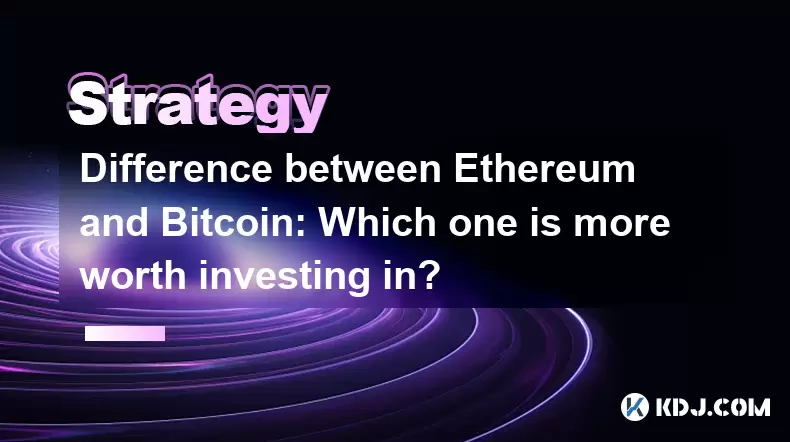-
 bitcoin
bitcoin $122090.672462 USD
1.59% -
 ethereum
ethereum $4493.758974 USD
0.56% -
 xrp
xrp $3.033145 USD
0.65% -
 tether
tether $1.000629 USD
0.00% -
 bnb
bnb $1169.854250 USD
7.07% -
 solana
solana $230.954786 USD
-0.19% -
 usd-coin
usd-coin $0.999785 USD
0.00% -
 dogecoin
dogecoin $0.256108 USD
-1.12% -
 tron
tron $0.342333 USD
-0.12% -
 cardano
cardano $0.859632 USD
-0.10% -
 hyperliquid
hyperliquid $48.932146 USD
-2.25% -
 chainlink
chainlink $22.345466 USD
-1.29% -
 ethena-usde
ethena-usde $1.000217 USD
-0.03% -
 avalanche
avalanche $31.203456 USD
1.93% -
 sui
sui $3.579145 USD
1.05%
Difference between Ethereum and Bitcoin: Which one is more worth investing in?
Bitcoin, launched in 2009, serves as a decentralized currency, while Ethereum, proposed in 2013, enables dApps and smart contracts, impacting investment choices.
May 25, 2025 at 05:00 am

The debate over whether to invest in Ethereum or Bitcoin is a common one within the cryptocurrency community. Both cryptocurrencies have unique features and purposes, making the decision dependent on various factors such as investment goals, risk tolerance, and market trends. This article will delve into the key differences between Ethereum and Bitcoin, helping you make an informed decision about which one might be more worth investing in.
Origins and Purpose
Bitcoin, launched in 2009 by an anonymous person or group known as Satoshi Nakamoto, was created as a peer-to-peer electronic cash system. Its primary purpose is to serve as a decentralized currency, free from control by governments and financial institutions. Bitcoin's main focus is on being a store of value and a medium of exchange.
On the other hand, Ethereum was proposed by Vitalik Buterin in 2013 and launched in 2015. Ethereum's purpose extends beyond just being a currency; it is a platform for building decentralized applications (dApps) and smart contracts. Ethereum's native cryptocurrency, Ether (ETH), is used to pay for transaction fees and computational services on the Ethereum network.
Technology and Functionality
Bitcoin operates on a blockchain technology that is specifically designed for secure and transparent financial transactions. The Bitcoin network uses a Proof of Work (PoW) consensus mechanism, where miners compete to solve complex mathematical problems to validate transactions and add them to the blockchain. This process is energy-intensive but ensures the security and immutability of the Bitcoin network.
In contrast, Ethereum also uses a blockchain but offers much more than just a payment system. Ethereum's blockchain is programmable, allowing developers to create smart contracts and dApps that can execute automatically when certain conditions are met. Initially, Ethereum used PoW like Bitcoin, but it has been transitioning to a more energy-efficient Proof of Stake (PoS) consensus mechanism called Ethereum 2.0. This shift aims to improve scalability and reduce the environmental impact of the network.
Market Performance and Adoption
Bitcoin is often referred to as 'digital gold' due to its established status as a store of value. It has a limited supply of 21 million coins, which contributes to its perceived scarcity and potential for price appreciation. Bitcoin has seen significant adoption by institutional investors, with many viewing it as a hedge against inflation and economic instability.
Ethereum, while also experiencing substantial growth, is valued differently due to its broader utility. The demand for ETH is driven not only by its use as a currency but also by the growing ecosystem of dApps and DeFi (Decentralized Finance) projects built on the Ethereum network. Ethereum's market performance is closely tied to the success and adoption of these applications.
Investment Considerations
When considering Bitcoin as an investment, one should look at its long-term potential as a store of value. Bitcoin's established track record and widespread recognition make it a relatively safer bet within the cryptocurrency space. However, its price volatility remains a significant risk factor, and investors should be prepared for substantial fluctuations.
Ethereum, on the other hand, offers a different investment proposition. Its potential for growth is closely linked to the development and adoption of the Ethereum ecosystem. Investors interested in Ethereum should consider the impact of technological upgrades like Ethereum 2.0, as well as the overall health and innovation within the DeFi and dApp sectors. Ethereum's price can be more volatile than Bitcoin's due to its broader range of use cases and dependencies.
Risks and Challenges
Both Bitcoin and Ethereum face various risks and challenges. Bitcoin is often criticized for its high energy consumption due to the PoW consensus mechanism. Additionally, regulatory scrutiny and potential bans in certain countries pose a threat to its adoption and value.
Ethereum also faces regulatory challenges, particularly with regards to the legality and compliance of smart contracts and DeFi projects. The transition to Ethereum 2.0 is another significant challenge, as it involves complex technical changes and could lead to temporary instability or security issues. Investors should be aware of these risks when considering an investment in Ethereum.
Community and Developer Support
Bitcoin has a strong and dedicated community that believes in its mission of creating a decentralized financial system. The development of Bitcoin is more conservative, with changes to the protocol being carefully considered and implemented to ensure stability and security.
Ethereum benefits from a vibrant and innovative developer community. The Ethereum ecosystem is constantly evolving, with new projects and improvements being introduced regularly. This active development can be a double-edged sword; while it drives innovation and growth, it also introduces more complexity and potential points of failure.
Frequently Asked Questions
Q: Can I invest in both Bitcoin and Ethereum?A: Yes, many investors choose to diversify their portfolios by investing in both Bitcoin and Ethereum. This strategy can help mitigate risk and take advantage of the unique strengths of each cryptocurrency.
Q: How do transaction fees compare between Bitcoin and Ethereum?A: Transaction fees for Bitcoin can be higher, especially during periods of high network congestion. Ethereum's fees have historically been variable but are expected to decrease with the implementation of Ethereum 2.0 and other scalability solutions.
Q: What are the tax implications of investing in Bitcoin and Ethereum?A: The tax treatment of cryptocurrencies varies by jurisdiction. In many countries, profits from selling Bitcoin or Ethereum are subject to capital gains tax. It's important to consult with a tax professional to understand the specific implications in your region.
Q: How can I store Bitcoin and Ethereum securely?A: Both Bitcoin and Ethereum can be stored in digital wallets. Hardware wallets like Ledger and Trezor offer high security for long-term storage, while software wallets like MetaMask and Trust Wallet are convenient for frequent transactions. Always ensure to follow best practices for securing your private keys.
Disclaimer:info@kdj.com
The information provided is not trading advice. kdj.com does not assume any responsibility for any investments made based on the information provided in this article. Cryptocurrencies are highly volatile and it is highly recommended that you invest with caution after thorough research!
If you believe that the content used on this website infringes your copyright, please contact us immediately (info@kdj.com) and we will delete it promptly.
- BlockDAG, DOGE, HYPE Sponsorship: Crypto Trends Shaping 2025
- 2025-10-01 00:25:13
- Deutsche Börse and Circle: A StableCoin Adoption Powerhouse in Europe
- 2025-10-01 00:25:13
- BlockDAG's Presale Buzz: Is It the Crypto to Watch in October 2025?
- 2025-10-01 00:30:13
- Bitcoin, Crypto, and IQ: When Genius Meets Digital Gold?
- 2025-10-01 00:30:13
- Stablecoins, American Innovation, and Wallet Tokens: The Next Frontier
- 2025-10-01 00:35:12
- NBU, Coins, and Crypto in Ukraine: A New Yorker's Take
- 2025-10-01 00:45:14
Related knowledge

Practical parameter settings for a Bitcoin multi-timeframe moving average system
Sep 18,2025 at 10:54pm
Optimizing Timeframe Combinations for Bitcoin Trading1. Selecting appropriate timeframes is crucial when building a multi-timeframe moving average sys...

How can I filter out false breakouts in Dogecoin high-frequency trading?
Sep 22,2025 at 01:00am
Understanding False Breakouts in Dogecoin Trading1. A false breakout occurs when Dogecoin's price appears to move beyond a defined support or resistan...

Techniques for identifying tops and bottoms in the Bitcoin on-chain NVT model
Sep 20,2025 at 07:54pm
Understanding the NVT Model in Bitcoin Analysis1. The Network Value to Transactions (NVT) ratio is often described as the 'P/E ratio' of the cryptocur...

What does the surge in open interest in Bitcoincoin futures mean?
Sep 20,2025 at 11:18pm
Understanding the Surge in Dogecoin Futures Open Interest1. A surge in open interest within Dogecoin futures indicates a growing number of active cont...

How can I use the Ethereum USDT premium to gauge market sentiment?
Sep 18,2025 at 11:55pm
Understanding the Ethereum USDT Premium1. The Ethereum USDT premium refers to the price difference between USDT (Tether) traded on Ethereum-based plat...

What should I do if Ethereum staking yields decline?
Sep 20,2025 at 06:18am
Understanding the Causes Behind Declining Ethereum Staking Yields1. The Ethereum network transitioned to a proof-of-stake consensus mechanism with the...

Practical parameter settings for a Bitcoin multi-timeframe moving average system
Sep 18,2025 at 10:54pm
Optimizing Timeframe Combinations for Bitcoin Trading1. Selecting appropriate timeframes is crucial when building a multi-timeframe moving average sys...

How can I filter out false breakouts in Dogecoin high-frequency trading?
Sep 22,2025 at 01:00am
Understanding False Breakouts in Dogecoin Trading1. A false breakout occurs when Dogecoin's price appears to move beyond a defined support or resistan...

Techniques for identifying tops and bottoms in the Bitcoin on-chain NVT model
Sep 20,2025 at 07:54pm
Understanding the NVT Model in Bitcoin Analysis1. The Network Value to Transactions (NVT) ratio is often described as the 'P/E ratio' of the cryptocur...

What does the surge in open interest in Bitcoincoin futures mean?
Sep 20,2025 at 11:18pm
Understanding the Surge in Dogecoin Futures Open Interest1. A surge in open interest within Dogecoin futures indicates a growing number of active cont...

How can I use the Ethereum USDT premium to gauge market sentiment?
Sep 18,2025 at 11:55pm
Understanding the Ethereum USDT Premium1. The Ethereum USDT premium refers to the price difference between USDT (Tether) traded on Ethereum-based plat...

What should I do if Ethereum staking yields decline?
Sep 20,2025 at 06:18am
Understanding the Causes Behind Declining Ethereum Staking Yields1. The Ethereum network transitioned to a proof-of-stake consensus mechanism with the...
See all articles










































































